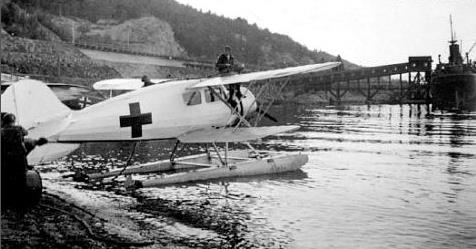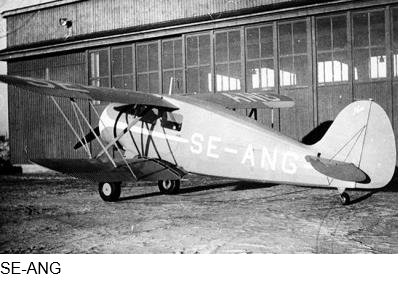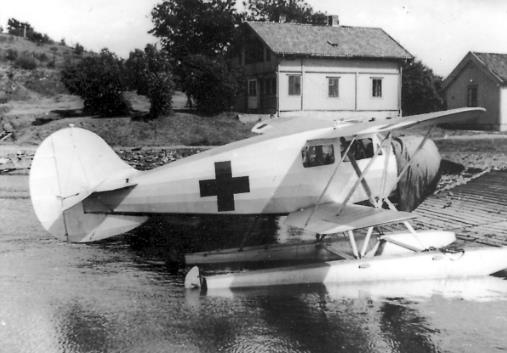| Type |
1 + 2 - 4 seat cabin biplane |
Floatplane fitted with 38-3430 Edo floats |
| Engine |
1 Jacobs L-4 |
| Dimensions |
Length 8,61 m , height , span 10,13 m , wing area , |
Length 8,79 m , height , span 10,13 m , wing area , |
| Weights |
Empty 817 kg, loaded 1293 kg, max. take off weight |
Empty 992 kg, loaded 1474 kg, max. take off weight |
| Performance |
Max.. speed 240 km/h, cruising speed , range , endurance , service ceiling , climb |
Max.. speed 209 km/h, cruising speed , range , endurance , service ceiling , climb |
| Type |
Werk.Nr |
Registration |
History |
| YKS-7 |
4603 |
LN-EAO SE-ANG |
Made in 1937 . Vest-Norges Flyselskap/Bergen to Sonnico/Oslo 23.04.37 Seized by Germany in October 1940, sold to Sweden .1943 to AB Bjorkvallsflyg , to Skand. Aero AB/Norrtalje 21.01.44 Crashed Lappland 18.2.45 |



All of the Waco Standard Cabins were powered by cowled radial engines and Waco tried to accommodate their customers preferences for many of the more common commercially available engines of the period, hence the profusion of designations, as the first letter indicates the engine installed. Individual models were each certified with various available engines but not all variations found customers.
Fuselage structure was typical for the period, being welded chrome-moly tubing with light wood strips to fair the shape in and covered with fabric. Wings were built around two solid spruce spars with the airfoil formed from trussed ribs made from plywood and spruce. The leading edge was covered in aluminum sheeting and the whole assembly covered in fabric. Ailerons were interconnected with a strut mounted to the trailing edge and on some versions were sheeted with ribbed aluminum. Most models were not fitted with flaps – the VKS-7F, built for the Civilian Pilot Training Program (CPTP) being the exception. It was fitted with split flaps only on the undersides of the upper wings and at mid chord, inboard and just ahead of the ailerons. Wing bracing was with a canted N strut joining upper and lower wings, assisted by a single strut bracing the lower wing to the upper fuselage longeron, there being no bracing wires. Elevators and rudder were built up from welded steel tubing braced with wire cables, and both could be trimmed, the elevators in flight and the rudder with a ground adjustable tab. Normally the main undercarriage was made up of a pair of vees, sprung with oleo/spring struts and provided with brakes as standard equipment, and a free-castoring tailwheel sprung with triangulated shock cords. was fitted to most aircraft, although a small number for Brazil were fitted with a tail skid. Floats were also offered as an option, starting with the UIC which had Edo P-3300 floats. Later types (including the UKC, YKC and CJC) were offered with Edo 38-3430 floats
The standard cabin series were Waco's first successful cabin biplane design, and was developed to accompany the F series airframe in their lineup. The Model C series had the top longerons raised to form a four-seat cabin which was entered through a door between the wings on the left side and had a rather distinctive rear-view window that was cleaned up, and then dispensed with in the later standard cabins. The initial QDC model of 1931 was offered with a 165 hp (123 kW) Continental A70 cowled engine, or as the BDC, ODC, PDC and UDC with other engines . 1932 saw the introduction of the OEC and UEC models. Continuous refinement and improvement by Waco Aircraft resulted in production of various sub-models continuing until 1939.
In 1935, Waco introduced its slightly larger Custom Cabin series (which featured a sesquiplane layout without ailerons on the lower wing) and decided to differentiate between the Standard and Custom Cabin types by appending an S to the model designator. in 1936 the C-S was replaced with an 'S' signifying 'Standard'. For example, the YKC of 1934 became the YKC-S of 1935 and the YKS of 1936, though with additional minor improvements.


